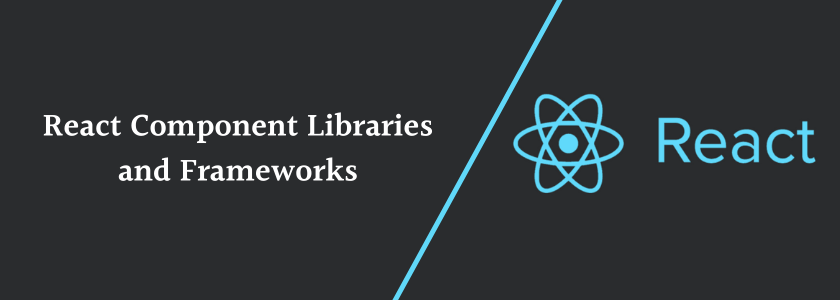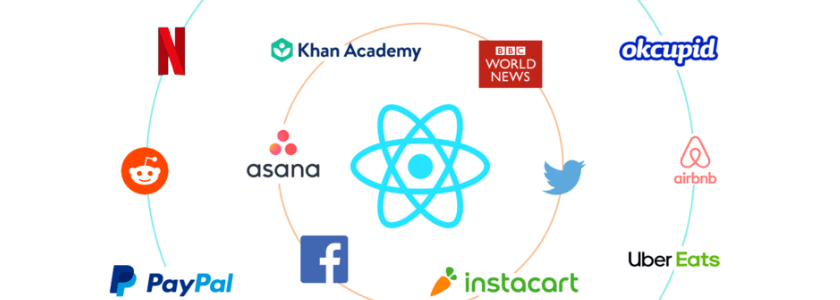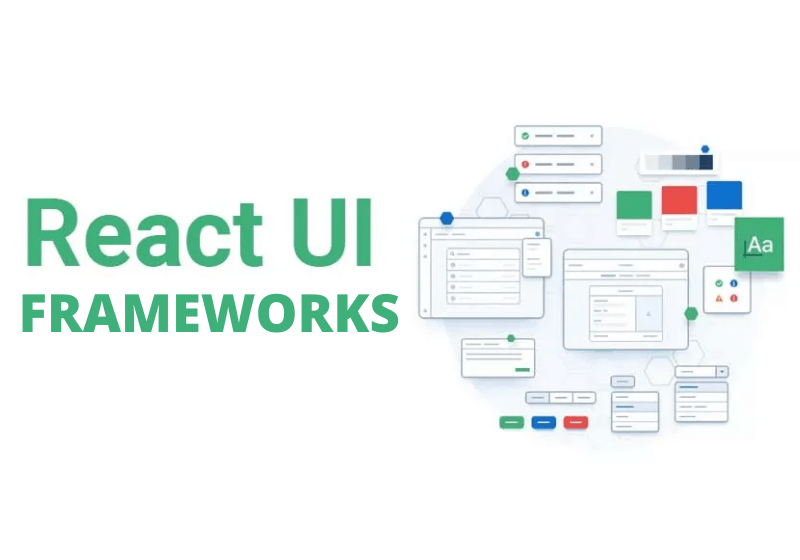React has put the whole developer community in awe of Javascript! To be more specific, it is how the ecosystem has matured into a mature community rather than an extension of React frameworks. One of the things driving ReactJS's growth is its extensive React component libraries.
ReactJS is one of the most widely used open-source web technologies for creating single-page apps.
Since its first release in 2013, Facebook's ReactJS JavaScript library has developed significantly, and developers have used it to construct a wide range of apps.
With these frameworks, developers have created some stunning user interfaces for mobile, desktop, web, and hybrid apps. These component libraries save us a lot of time and work when it comes to developing contemporary React apps. They include pre-built components like icon sets, buttons, form input, menu, pagination, date and time picker, and so on.
These component libraries will not only ease app UI creation for current ReactJS developers, but they are also very adaptable once you start working with them due to their high modularity. React offers many high-performance component libraries, and some of the best will be featured in this piece.
What is a React Component Library?

React is a JavaScript framework that allows you to create stunning user interfaces for both online and mobile apps. It interacts well with other JavaScript frameworks and libraries and contains tiny, reusable pieces of code known as components. React Component Library is a collection of components that are shown prominently and primarily provide a means to explore and sample those components and their related materials.
List of Top React Component Libraries
Choosing the best React component libraries for your application might be difficult, as there are so many React libraries and frameworks available nowadays.

To make your job easier, we've compiled a list of the top ten React component libraries.
1. Material UI- Notable React UI Library
Material UI is one of the largest popular React libraries, containing all of the material design features for usage in any React project. On GitHub, it has over 71.7k stars and 24.2k forks. Material UI is one of the most dependable React frameworks for providing easily accessible and configurable UI components. Material UI includes layout, form, navigation, data display, and many more widget components.
This library also has optional CSSBaseline components that aid in the correction of uneven UI behavior across multiple React-based browsers, regardless of device compatibility.
It is a CSS-in-JS solution that allows you to style your components in "@material-ui/styles," making it quick and adaptable, with the same benefits as styled components.
Material UI is used by companies such as Netflix, Spotify, and Nasa to create flexible design solutions.
2. Ant Designs- React UI Library
Ant Design React is one of the best React component libraries, with a large number of high-quality components and prototypes for building rich, engaging user interfaces. It supports internationalization for various languages and styles components with Less.js. The Ant Design framework allows for design customization.
Ant Design components include buttons, icons, breadcrumbs, grids, dropdowns, and pagination. It also has a mobile-friendly version for developing mobile applications. This component library is notable for its diverse and one-of-a-kind client base. It also lets you stack your UI components and painless integration, which results in a more fluid user experience.
3. React Router- Routing & Navigation React Library
The React Router, a collection of navigational components, synchronizes the UI components with the browser's address. React router makes navigating in a single-page app easier for the developer.
It also supports realistic nesting, reliable screen-to-screen transitions, and server-side rendering.
If you're building a React project, it'll be useful to have some components that you can combine declaratively in your app. The React router is a grouping of similar components.
4. Create React App- React CLIs and Boilerplates
Create-React-App is a command-line program that does not require any construction settings. It encourages the development of your standards and enables you to begin the app development process smoothly. There is just one build dependency required, thus no additional complexity is involved. This CLI tool is better-suited to building basic web projects and includes underlayers like Webpack Babel, EsLint, and others.
5. React Bootstrap- React UI Library
React Bootstrap is one of the greatest React component libraries for replacing bootstrap JavaScript with React. React Bootstrap, which was designed with compatibility in mind, provides you more flexibility over reusing and integrating UI components than any other UI framework. Each component is designed in the React component style. It implies that unneeded libraries such as jQuery are no longer present.
The React community will be of great assistance to you. As a result, React-Bootstrap is a fantastic solution for your app's UI foundation.
It gives back the old delight of using compatible Bootstrap themes, together with the Bootstrap CSS. Developers may code more quickly and effectively by employing reusable and quicker coding approaches.
6. Redux- Statement Management React Library
Redux is a free-standing framework and a predictable state container that is typically used with React UI library components, however, it can also be used with Angular, Vue, Ember, and Vanilla JS, among others.
It is compatible with both frontend and backend libraries. As Redux reduces the requirement for props or callbacks to connect React components to bits of state. The library is frequently referred to be a developer's closest friend. It aids in the creation of a uniform code and is environmentally beneficial. . It has a large number of add-ons despite its modest size of 2KB. It necessitates the use of a "UI binding" library to communicate with the UI framework rather than any direct connectivity to the store. You may also make changes to the code while your app is running. React Native features its own Redux library, React-Redux.
7. React Hook Form- Form React Library
React Hook Form is a minimalist library with no dependencies. React Hook Form is used in conjunction with React Hook APIs. But, exactly, what does it do? There are frequently some native HTML inputs and uncontrolled components. The validation becomes easier as the library aligns UI along with the standards of existing HTML. It was created with Typescript to aid in the creation of a form data type that would handle form values.
It also combines uncontrolled components with native HTML inputs. It is adaptable when it comes to working with third-party React UI component frameworks. It eliminates errors by reducing the re-rendering time by up to twenty times that of Formik or Redux Form. Furthermore, it may be integrated with React state management frameworks.
8. React Motion- Animation React Library
React-motion, a popular animation package, defines the animation using spring configuration. As a result, it alleviates your concerns concerning controlled duration and complexity. You don't have to be concerned about interrupting animations. To a large part, the API gets simpler. Using damping, stiffness, and accuracy techniques, this animation library significantly streamlines the development flow within React components.
The React-Spring API bridges the gap between the imperative and declarative methods. Furthermore, you may anticipate a safe, shared transition.
9. Semantic UI React
Semantic UI React library is widely regarded as the finest component library for the Semantic UI web development platform. It is a jQuery-free React UI component framework used by organizations such as Netflix and Sublime Fund.
The Semantic UI JavaScript framework, with its semantically friendly and concise code, enables programmers to easily create attractive and intuitive layouts. There is no shortage of customizable components, allowing you to express yourself freely.
It conforms to an adaptable React Ecosystem as a declarative API. Having shorthand props, on the other hand, lowers the load of a fast coding process. Developers may quickly construct attractive and responsive web designs using syntactically and cohesive code using the Semantic UI React framework. However, one may find Semantic UI React a little complex at first.
10. React 360- AR/ VR React Library
We live in an augmented and virtual reality era. Nowadays, most firms, particularly those in retail or e-commerce, provide AR/VR experiences that allow customers to virtually test out their products. Wouldn't it be great if you could develop an AR/VR experience with React?
React 360 enables the creation of fascinating 360 and VR experiences with React, which is available on PCs, mobile phones, and VR devices. It makes it easier to create sophisticated 3D and VR user interfaces. React 360, like its predecessor, React VR, employs familiar tools and concepts to provide consumers with an engaging and compelling experience.
React 360 interacts with 360-degree areas using apps that mix 2D and 3D interfaces. It claims the development of picture and video viewers, 360 tours, traditional adventure games, and provide rich multimedia.

Wrapping Up!
React Library is a somewhat large and fascinating subject.
Organizations will be able to do typical Javascript tasks by using these libraries. The first step in selecting a React component library should be determining your project's requirements. Once you understand the criteria, the quest will become very straightforward. There are several such libraries on the market, and it is not easy to choose one. Thus always investigate and gather information before making a decision.
However, there is a chance that you will not discover a library dedicated just to your work. However, if you are a business wanting to complete a project quickly, you may outsource a competent and experienced React Developer. Contact Us, Terasol technologies, and we will help you build the project for you.
Do leave a comment with your favorite React library.


